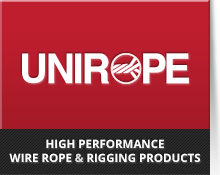Broken Wire Criteria Indicating Rope Removal
| Based on ASME B30.30-2019 | ||||||||
|---|---|---|---|---|---|---|---|---|
| Over Length of 6 x Nominal Rope Diameter |
Over a Length of 30 x Nominal Rope Diameter |
|||||||
| B30.30 Rope Type |
Standard and Python® Rope Construction |
Within a Single Strand |
Across All Strands |
Across All Strandsy |
Of the Valley Break Type 1 |
At End Termination 2 |
||
| Running Rope | ||||||||
| ≤ 6 strands, 19 class | 6×19, 4-Runner | 3 | 6 | 12 | 2 | 2 | ||
| > 6 strands, 19 class | Super 8R, 8V, 8C, 8CD, Power 9, Ultra | 4 | 8 | 16 | 2 | 2 | ||
| ≤ 6 strands, 36 class | 6×36 | 5 | 10 | 20 | 2 | 2 | ||
| > 6 strands, 36 class | 8×36 | 6 | 12 | 24 | 2 | 2 | ||
| Rotation Resistant | ||||||||
| Category 1 | Compac 35, Compac 35P | N/A | 6 | 12 | 2 | 2 | ||
| Category 2 | 19×7, 19×19, Compac 18 | N/A | 2 | 4 | 2 | 2 | ||
| Category 3 | Multi | N/A | 2 | 4 | 2 | 2 | ||
| Standing Rope | ||||||||
| ALL | — | 3 | — | — | 2 | |||
|
GENERAL NOTE: Broken wire rope-removal criteria cited in B30.30 apply to wire rope operating on steel sheaves and cast iron sheaves and drums and wire rope operating on multilayer drums, regardless of sheave material. When drum spooling is single layer, synthetic or sheaves with synthetic linings should not be used because there are no broken wire criteria for this configuration, and internal wire breaks may occur in large numbers before any break or signs of substantial wear are visible on the outside wires of the rope.
Notes: 2) Broken wire at end terminations may be eliminated by cutting and reattaching the end termination, if reducing the length is allowable. |
||||||||
Rope Removal and possible Cause
| Fault | Possible Cause |
|---|---|
| Accelerated Wear |
|
| Rapid Appearance of Broken Wires |
|
| Corrosion |
|
| Kinks |
|
| Excessive Localized Wear |
|
| Stretch |
|
| Broken Wires Near Fitting |
|
| Sheaves/Drums Wear Out |
|
| Pinching, Crushing, Oval Shape |
|
| Rope Unlays (Opens Up) |
|
| Reduction in Diameter |
|
| Bird Cage |
|
| Core Protrusion |
|



